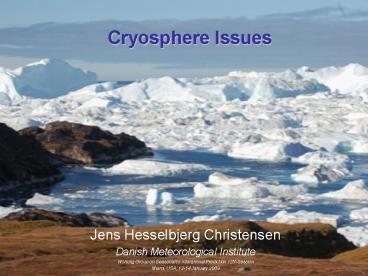Cryosphere Issues - PowerPoint PPT Presentation
1 / 35
Title:
Cryosphere Issues
Description:
Cryosphere Issues – PowerPoint PPT presentation
Number of Views:50
Avg rating:3.0/5.0
Title: Cryosphere Issues
1
Cryosphere Issues
- Jens Hesselbjerg Christensen
- Danish Meteorological Institute
- Working Group on Seasonal to Interannual
Prediction 12th Session - Miami, USA, 12-14 January 2009
2
Overview
- Linkages with CliC
- The cryosphere in seasonal prediction
- A question of time scales
- Cryospheric processes that influence the climate
system - CliC modelling activities some examples
- How can CHFP be analysed regarding the
cryosphere? - Modelling and initialising sea-ice
- Arctic customers?
3
TFSP Hypothesis (Kirtman 2005)
- There is currently untapped seasonal
predictability due to interactions (and memory)
among all the elements of the climate system
(Atmosphere-Ocean-Land-Ice) - Seasonal Predictability Needs to be Assessed with
Respect to a Changing Climate - Use IPCC Class Models Relevance
- Weather Prediction Models (NWP Resolution) Should
also Tested on Seasonal Time Scales - Collaboration with THORPEX
4
Interactive Atmosphere-Ocean-Land-Ice Prediction
Experiment
- Best Possible Observationally Based
Initialization of all the Components of Climate
System - Seven Month Lead Ensemble (10 member) Fully
Interactive Predictions of the Climate System - Predictions Initialized Four Times per Year for
Each Year 1979-Present - Some Predictions by Some Groups Extended to
Decadal - Interactive Model
- Ocean Open but interactive (e.g., slab mixed
layer or GCM) - Atmosphere Open but interactive, most likely a
GCM - Land Open but interactive, e.g. SSiB, Mosaic,
BATS, CLM, Bucket - Ice Open but interactive (e.g., thermodynamic
or dynamic)
5
Enhancing the Relevance of the WCRP Programs
- GEWEX
- Provides Guidance on How to Initialize Land
Surface - Proposes/Implements Diagnostic Studies and
Numerical Experiments Understanding Land Surface
Feedbacks - Assessing Seasonal Forecasts
- CliC
- Provides Guidance on How to Initialize Cryosphere
- Proposes/Implements Diagnostic Studies and
Numerical Experiments - Assessing Seasonal Forecasts
- CLIVAR
- Provides Guidance on How to Initialize
Ocean-Atmosphere - Proposes/Implements Diagnostic Studies and
Numerical Experiments Understanding
Atmosphere-Ocean Coupling and Variability - Assessing Seasonal Forecasts
- SPARC
- Provides Guidance on How to Prescribe Atmospheric
Composition - Provides Guidance on How to Initialize
Stratosphere - Proposes/Implements Diagnostic Studies and
Numerical Experiments - Assessing Seasonal Forecasts
6
CliC Goal and Objectives
- Principal Goal
- Assess and quantify the impacts of climatic
variability and change on components of the
cryosphere and their consequences for the climate
system, and determine the stability of the global
cryosphere - Supporting Objectives
- Enhance the observation monitoring of the
cryosphere in support of process studies, model
evaluation and change detection - Improve understanding of the physical processes
and feedbacks through which the cryosphere
interacts within the climate system - Improve the representation of cryospheric
processes in models to reduce uncertainties in
simulation of climate and predictions of climate
change
7
Components of the cryosphere
8
Major Cryospheric Related Issues in Climate
Research
- Arctic Ocean Sea-Ice Cover
- understanding of recent past changes and future
- Possible changes in the THC
- Mean Sea Level Rise
- Stability of the West Antarctic Ice Sheet
- Potential release of C from frozen ground to
atmosphere - Carbon balance, possibilities of sequestration
- Role of Tibetian Plateau in Monsoon Variability
9
Location of land ice (glaciers, ice caps, and ice
sheets) north of 60ºS
Note time scales for change but well monitored
10
Cryospheric changes
- Sea ice
- Snow cover
- Glaciers
- Ice sheets and shelves
- Permafrost
11
Atlas of Canada
12
September sea-ice
13
(No Transcript)
14
(No Transcript)
15
Figure 8.10
September
March
Sea ice in current climate as seen by models
IPCC AR4
16
A sea ice model LIM
First-year sea-ice growth and decay at Barrow
17
(No Transcript)
18
(No Transcript)
19
Snow 2002/2003 MODIS
NASA
20
Northern Hemisphere Satellite-Derived Snow
Extent1978 2006 Visible (NOAA) Passive
Microwave (SMMR SSM/I)
21
Northern Hemisphere 1978 2006 visible and
passive microwave snow-covered area (x 106 km2)
departures from monthly means (12 month
smoothed).
22
Spring duration of snow cover Trends derived
from visible satellite data, 1978-2006.
23
Flato pers. Comm.
Baseline climate (19801999) terrestrial snow
cover distribution in February in the Northern
Hemisphere simulated by eight AOGCMs
24
Circum-Arctic map of permafrost conditions
24.5 of Northern Hemisphere southernmost extent
28N
25
Zhang 2005
26
Seasonally frozen ground
Zhang 2003
27
(No Transcript)
28
Formulation of soil processes(CCLM)
Deadhorse
Nicolsky et al. 2007
Lid at 3.43m
29
Formulation of soil processes(CCLM)
Deadhorse
Nicolsky et al. 2007
Lid at 80m
30
CHFP data issues as seen from CliC
- Inventory of data available
- Strong CliC component
- Should imply a justification for a WCRP data
management approach - Challenge uniform initialisation data set
- Specify common format for model output
- CMIP5?
- Model resolution is an issue
- Complicates comparison
31
Skill of nine ten-year-long predictions, evenly
over the period 19552005 Keenlyside et al.
Nature (2008)
32
Possible WGSIP/CliC interaction
- Interactive/prescribed snow cover
- Do we know if snow is impacting skill apart from
Tibetan plateau? - Role of frozen grounds
- Lower boundary conditions
33
CLIPS in Polar Regions
- WMO Climate Information and Prediction Services
(CLIPS) - WMO recognizes a unique opportunity for the NMHSs
of its Members to contribute to the legacy of the
ongoing International Polar Year 2007-2008 (IPY),
to build collaborative mechanisms for generating
sustained, practical, operational products and
services, to meet user needs for climate risk
management in Polar Regions. - a Workshop on CLIPS in Polar Regions Climate
Product Generation, User Liaison and Training
was held in St Petersburg, Russian Federation
from 8-11 September 2008
34
Location of land ice (glaciers, ice caps, and ice
sheets) north of 60ºS
Note time scales for change but well monitored
35
THE END

